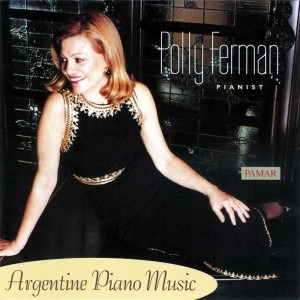
artist: — Polly Ferman
title: — Argentine Piano Music
date: — CD released in 1998
Music by Piazzolla, Williams, Aguirre, Buchardo, Ramos, Troilo, Guastavino, Ginastera.
“The remarkable P. Ferman displayed by turns considerable power and exquisite sensibilities, while exhibiting an astonishingly wide range of tonal hues. What deeply resonant tones her touch yielded! Argentine music came vibrantly alive as Mrs. Ferman eminently succeeded in capturing and conveying the substance, spirit and essence or Argentine music.”
The Phillipine Star
Liner Notes:
Argentine Piano Music
Buenos Aires has one of the world’s premier opera houses, the peerless Colón. It has good orchestras and a vigorous concert life. As Latin America’s major musical center, it has been a magnet for international performers. During the first decades of the 20th century, it also had so many conservatories that Pablo Casals and Harold Bauer nicknamed it “conservatropolis.” Among the instruments, the piano reigned supreme, and Arthur Rubinstein called Buenos Aires “an extremely piano-minded city.” Therefore, it is not surprising to find a large body of piano music written by Argentinian composers, most of them stimulated by the nationalist movement. They made extensive use of the songs and dances of their country and were most successful writing in small form.
Vidalita is an example of a folk song, derived from the Peruvian yaravi, written for the piano by the prolific and influential Alberto Williams (1862-1952), a pioneer who attempted to create an indigenous style in some of his works.
However, the most representative composer of the early nationalist style was Julián Aguirre (1868-1924). Aaron Copland singles out Aguirre as well as the Cuban Ignácio Cervantes as composers of a type of “sensitive, almost Chopinesque piano piece with a Creole flavor.” Aguirre was admired by Albéniz. Some of his dances were orchestrated by Ernest Ansermet, and Arturo Toscanini conducted his music. Aguirre studied in Spain, made a reputation as a pianist and is the author of many piano pieces. Among them there is the lively Gato, a dance most popular in the countryside of Argentina throughout the 19th century, the introspective Tristes, sad, melancholic songs of Inca origin, popular in Western South America, also derived from yaravi, and a Gaucho dance, the exuberant Huella, which is fittingly dedicated to the young Rubinstein.
Carlos Lopez Buchardo (1881-1946) is another composer who stands out among the followers of the nationalist movement. In his memoirs, Rubinstein praises him as a “clear genuine talent,” whose music was “full of the enchanting rhythms of the songs and dances of his country.” The Canción del Carretero is one such song, written in a fluid pianistic style. It is one of Buchardo’s best known pieces.
Juan José Ramos (1930-1995) studied in Argentina, France, and Spain. His most renowned teacher was Manuel de Falla. The music written by Ramos is predominantly based on the tango and the milonga, of which the Milonga Sureña and the Milonga del Riachuelo are voluptuous examples.
Although many consider the milonga the most characteristic Argentine city dance, it is difficult to distinguish the milonga, at least on paper, from the habanera and the early tango, since they share the same basic rhythm.
The tango had its beginnings in the bordellos of the arrabal, the poor neighborhoods of Buenos Aires. Originally it was danced by men only. At first it was shunned by “decent” Argentine society, for it was thought to be immoral. Only after its international success, it was embraced by the whole country. Today, no musical form represents Argentina more eloquently than the tango.
La Trampera (milonga) is a humorous example of the work of Anibal Troilo (1914-1975), the beloved “Pichuco,” a composer of many famous tangos and a brilliant player of the bandoneón.
Astor Piazzolla (1921-1992) began playing the bandoneón in Troilo’s “Orquesta tipica” as a young man. He studied with Ginastera and Nadia Boulanger, and was largely responsible for the revival of the tango, which had lost some of its popularity in the 1950’s. Piazzolla brought the tango to the concert halls of the world. The Suite Piazzollana, arranged by Osvaldo Requena includes Chau Paris, Francanapa, Balada para un Loco and Adiós Nonino. Piazzolla has become one of the best known composers of the late 20th century. In 1997 Bernard Holland wrote in the New York Times “since the death of Messiaen, unblemished passion like this has not been easy to come by.”
Carlos Guastavino (born in 1914) has been immune to modernity. His romantic music is a throwback. An excellent pianist, he helped disseminate his own music. El Patio and El Sauce belong to a set of preludes. Bailecito is a dance from the north of Argentina, Bolivia, and Peru.
The nationalist movement culminates in the work of Alberto Ginastera (1916-1983), who divided his own output into three consecutive phases: objective nationalism, subjective nationalism, and neo-expressionism. The Danzas Argentinas (1937) and the Suite de Danzas Criollas (1946) belong to the first phase of his creative evolution. Ginastera’s work is a superior example of modern nationalism. Its importance was quickly perceived by many. Copland predicted, in 1941, that young Ginastera would someday become “an outstanding figure in Argentine music.” He was right.
©William Daghlian
New York, 1998